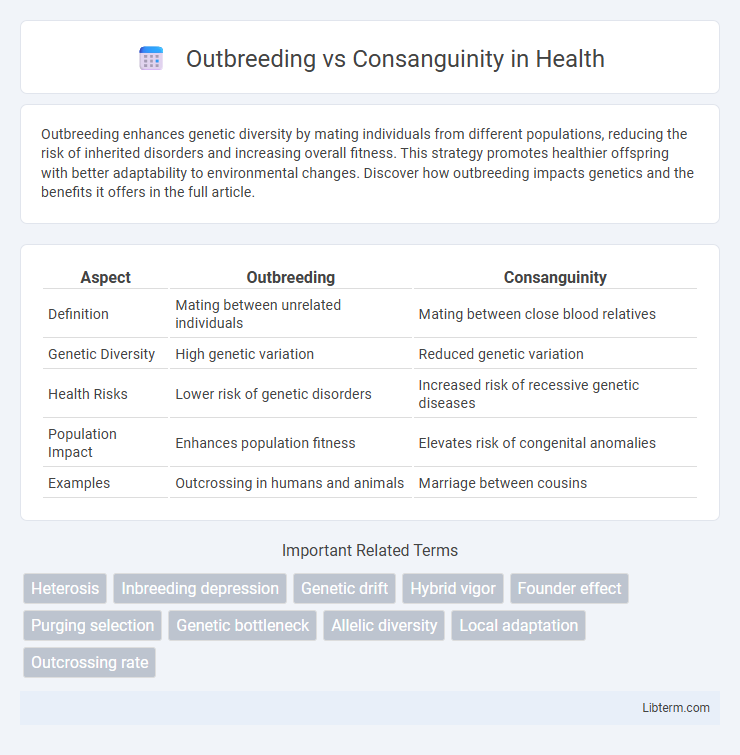Outbreeding enhances genetic diversity by mating individuals from different populations, reducing the risk of inherited disorders and increasing overall fitness. This strategy promotes healthier offspring with better adaptability to environmental changes. Discover how outbreeding impacts genetics and the benefits it offers in the full article.
Table of Comparison
| Aspect | Outbreeding | Consanguinity |
|---|---|---|
| Definition | Mating between unrelated individuals | Mating between close blood relatives |
| Genetic Diversity | High genetic variation | Reduced genetic variation |
| Health Risks | Lower risk of genetic disorders | Increased risk of recessive genetic diseases |
| Population Impact | Enhances population fitness | Elevates risk of congenital anomalies |
| Examples | Outcrossing in humans and animals | Marriage between cousins |
Understanding Outbreeding: Definition and Basics
Outbreeding refers to the mating of unrelated individuals within a species, promoting genetic diversity and reducing the risk of inherited disorders. This practice contrasts with consanguinity, where closely related individuals reproduce, increasing the probability of recessive genetic conditions. Understanding outbreeding is essential for genetic health, population viability, and evolutionary adaptability.
Consanguinity Explained: What Does It Mean?
Consanguinity refers to the genetic relationship between individuals who share common ancestors, typically resulting in offspring with higher chances of inheriting recessive genetic disorders. This biological connection is significant in understanding genetic risks and hereditary disorders within family lines. Medical genetics often examines consanguinity to assess potential health impacts and guide genetic counseling.
Genetic Diversity: The Impact of Outbreeding
Outbreeding significantly enhances genetic diversity by introducing new alleles from unrelated individuals, reducing the risks of recessive genetic disorders common in consanguineous populations. Increased heterozygosity resulting from outbreeding promotes stronger immune responses and greater adaptability to environmental changes. This genetic variability is crucial for maintaining population health and evolutionary resilience.
Risks and Consequences of Consanguinity
Consanguinity, or intermarriage between close relatives, significantly increases the risk of autosomal recessive genetic disorders due to the higher probability of inheriting identical deleterious alleles from both parents. Studies link consanguineous unions to elevated incidences of congenital malformations, genetic diseases, infant mortality, and overall reduced genetic diversity within populations. Unlike outbreeding, which promotes heterozygosity and genetic health, consanguinity intensifies genetic load, posing severe public health concerns particularly in communities with prevalent cousin marriages.
Outbreeding Vs Consanguinity: Key Genetic Differences
Outbreeding increases genetic diversity by mating individuals from unrelated gene pools, reducing the risk of inherited genetic disorders caused by recessive alleles. Consanguinity, the mating of closely related individuals, raises the probability of homozygosity and the expression of deleterious recessive traits, leading to higher incidences of genetic diseases. The key genetic difference lies in outbreeding's promotion of heterozygosity versus consanguinity's tendency to increase genetic homogeneity within offspring.
Health Implications: Outbreeding Benefits
Outbreeding significantly reduces the risk of genetic disorders by increasing genetic diversity, which enhances overall population health and resilience. It decreases the probability of inheriting recessive genetic diseases commonly associated with consanguineous unions. Studies show that outbreeding leads to improved immune system function, greater fertility rates, and lower infant mortality compared to consanguineous relationships.
Consanguinity and Inherited Disorders
Consanguinity, the genetic relationship between individuals who share common ancestors, significantly increases the risk of inherited disorders due to the higher probability of offspring inheriting recessive genes from both parents. Populations with frequent consanguineous marriages exhibit elevated rates of autosomal recessive disorders such as cystic fibrosis, thalassemia, and sickle cell anemia, leading to increased morbidity and mortality. Genetic counseling and screening are crucial in consanguineous unions to identify carrier status and reduce the incidence of inherited diseases.
Sociocultural Factors Influencing Mating Choices
Sociocultural factors significantly influence mating choices, with outbreeding often promoted in societies valuing genetic diversity and avoidance of hereditary diseases, while consanguinity persists in cultures emphasizing familial alliances, property retention, and social cohesion. Religious beliefs, traditional norms, and socioeconomic status also shape preferences, impacting marriage patterns and gene flow within populations. These cultural determinants create distinct reproductive strategies that affect genetic health and demographic structures globally.
Global Prevalence of Outbreeding and Consanguinity
Outbreeding, characterized by mating between unrelated individuals, exhibits high global prevalence in regions with diverse populations, such as North America and Western Europe, promoting genetic diversity and reducing hereditary disorders. Consanguinity, defined as marriage between relatives, is predominantly observed in parts of the Middle East, South Asia, and North Africa, where cultural and social factors influence its practice, often increasing the risk of autosomal recessive diseases. Global prevalence patterns highlight the balance between genetic variation from outbreeding and potential health risks associated with consanguineous unions.
Future Perspectives: Genetics and Human Populations
Future perspectives in genetics emphasize the impact of outbreeding on increasing genetic diversity and reducing the prevalence of hereditary disorders within human populations. Advances in genomic technologies enable precise monitoring of gene flow and mutation patterns, facilitating personalized medical interventions and population health management strategies. Research on consanguinity highlights its role in maintaining rare genetic traits but underscores the increased risk for autosomal recessive conditions, guiding genetic counseling and reproductive decision-making.
Outbreeding Infographic

 libterm.com
libterm.com